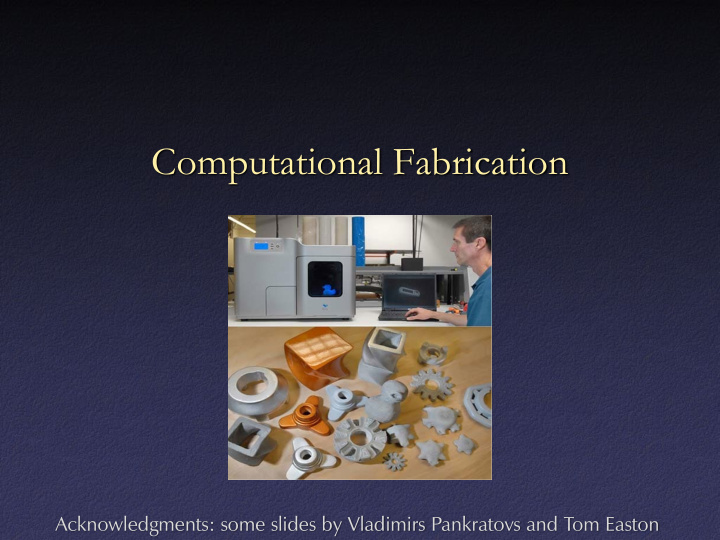



Computational Fabrication Acknowledgments: some slides by Vladimirs Pankratovs and Tom Easton
Digital Fabrication Technologies • Subtractive: computer-controlled milling – Materials: metal, wood, plastic, stone – Key parameter: # of axes • 3-axis machines can only produce height fields • 4- through 6-axis machines available: more flexible
Digital Fabrication Technologies • Additive: “3D printing” of one slice at a time
3D Printing Pipeline • Slice 3D model, build object layer by layer – Typically a few layers / mm, but >50 for some machines • Slow: can take hours – But it is getting better—rapidly!
3D Printing Technologies • Laminated object manufacturing • Fused deposition modeling (FDM) • Selective laser sintering (SLS) • Stereolithography
Laminated Object Manufacturing • Cut thin layers of material (plastic, cardboard, etc.) with laser, mill, or knife • Assembled by hand
FDM • Extrude a bead of semi-liquid material (heated plastic, plaster, wax, chocolate, etc.) to form solid layers
FDM
SLS • Form layer of small particles: plastic, metal, ceramic or glass powders • Fuse (sinter) with high-power laser
SLS
Stereolithography • Tank of liquid resin • Polymerize (harden) a layer at a time with UV laser
Stereolithography
Variant: Objet Connex • Variety of UV-curable materials deposited by “inkjet” heads
Variant: Z-Corporation • Solid powder with binder deposited by “inkjet” heads
Limitations • Slow • Expensive – Until recently, there were only industrial machines priced from $20k… High end at $500k+ • Surface layering visible – Often higher resolution within a layer than layer thickness (except for FDM)
But… • Print shops are cropping up – E.g., Shapeways • Specialized products – Christmas ornaments with your face – Masks – Artwork – Fetuses • “The London Ultrasound Centre in the UK offers the ability to take a 3D scan of your offspring - before birth - and produce a 3D print of the child. Actually, the 3D Print is simply used to create a mold for subsequent bronze casting. There's no official pricing on the Centre's website for this service, but according to the Daily Mail, it costs 1,200 pounds sterling (or around USD$1,800) and takes several weeks to deliver!”
For the DIY Crowd • MakerBot, Bits From Bytes, Fab@Home – A few thousand $$ • RepRap – Under $1,000 for parts (and it can print parts for new machines!)
Where Is It Going? • The low-end prices are (in constant dollars) where the PC was in mid-70s – So is the relative maturity! • Prices will drop, capabilities will improve – 3D printers in every home in 20 years?
The Design Economy • When people can turn a computer file into a useful solid object, those computer files will become products • People with CAD skills, or 3D scanners, will make them • People with printers will buy them • Another opportunity for the developing world?
New Business Models • Sell (and customize) 3D models, not widgets • Sell raw materials • Sell equipment to recycle materials • Sell a printer linked to file source (Think Kindle!)
Emerging Applications: Bioprinting
Emerging Applications: Food
Emerging Applications: Architecture
Towards Computational Fabrication • Going beyond simple slicing to enable design for desired appearance, deformation, structural properties, etc. • As with computational photography: the ability to perform complex computation allows for a greater range of capabilities
Computational Fabrication Pipeline Printer Goal Capabilities 3D Model Simulation Optimization Fabrication
Recommend
More recommend